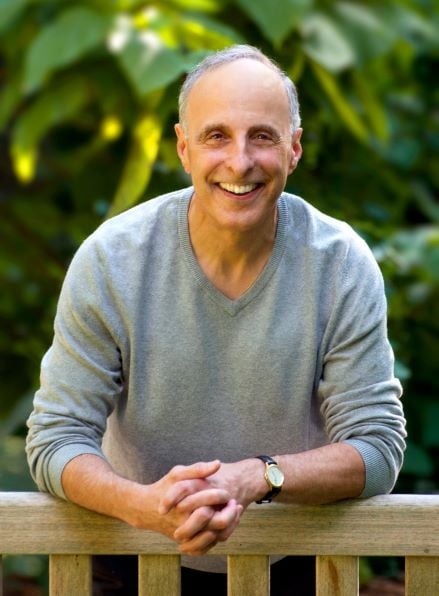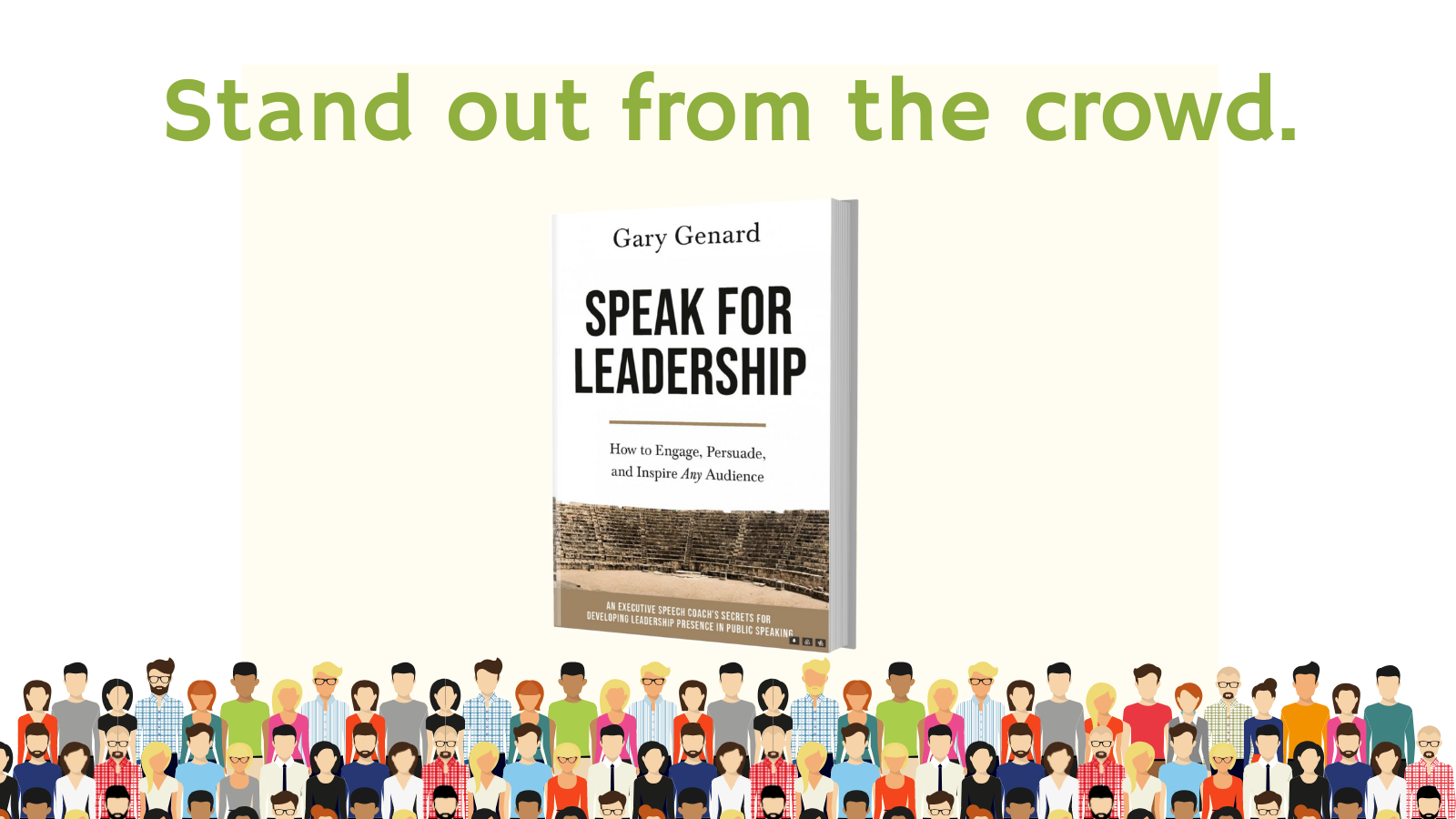Want to bring down the house with your speeches and presentations? Your PowerPoint won't do it! Here's how to acquire stage presence for public speaking.
Whatever else you're doing right now, I know you're wondering, “What are the practical skills that will allow me to be fully present in my presentations and hold audiences spellbound?”
Well, I can answer that! Before I do, though, I'll have to pose another question: What do we mean by public speaking performance, anyway? As I’ve said before, it’s a form of communication that doesn’t only involve speeches and presentations. What about conversations, networking, job interviews, pitching ideas, contributing at meetings (live and virtually), and so on?
It's you, not your data points that make what you say come to life in these situations! Stand out from the crowd with Speak for Leadership. Click on image below to learn more.
All of these situations call upon precisely the same skills you use in public speaking. These include vocal delivery, body language, eye contact, listening, showing empathy, answering questions, etc. These interactions accomplish the same purpose as speaking in public in terms of being heard and influencing people. And often, there’s a public setting involved.
Sometimes we're awkward here too—such as having to introduce ourselves. Get confident! Download my Free resource, "How to Introduce Yourself in a Professional Situation."
But something mysterious happens when we compare these scenarios with PUBLIC SPEAKING(!!). Tasked with presentations and speeches, for some reason we begin focusing on our deficiencies. Right? So, starting right now, I’d like you to accept that all of these scenarios require you to simply share your ideas with others. If chatting with someone doesn’t make you doubt that you can speak for leadership, why should delivering a presentation with a slide deck or a spreadsheet make that happen?
Successful Speaking = Connecting with Listeners
People who come to public speaking from an administrative or event-oriented standpoint tend to underestimate the power of performance. For instance, Chris Anderson of TED says “getting the words, story, and substance right is a much bigger determinant of success or failure than how you stand or whether you’re visibly nervous."1
When speaking situations like conferences or annual meetings are on the menu, you need my Public Speaking Handbook: How to Give a Speech. Download a Free chapter here.
I don’t believe this is true. If you attend academic conferences, you know that nearly every speaker stands at center-stage and reads their research paper, word for word. The “substance” is certainly right. But the experience is about as exciting as watching an animal lie sleeping in a zoo. There’s intelligence, energy, and dynamism in there somewhere, but the owner isn't interested in displaying any of it.
No matter how technical or analytical a talk, it has to have some blood racing in its veins if it's part of a public performance. Here’s an example of what happens when the veins are empty:
I often train physicians and hospital leadership teams in presentation performance. A few years ago, I was conducting a daylong seminar for a group of oncologists. Over lunch, one of them leaned over to me and said, “You know, I travel around the world to hear leading scientists and researchers in my field. But so often, this person will get to the lectern and bury his nose in his notes and drone on and on. Within five minutes, everyone is looking at their cell phone. I get so frustrated, because this is someone who is doing truly exciting work. And it all turns out to be so un-engaging that it seems a huge waste of time.”
Learn how to be a memorable public speaker that people want to hear! Get my Free resource, "Great Speaking? It's About Performance Over Content." Download it now!
Clearly, these physician-speakers are getting the substance right. But the absence of performance skills is a key factor in their failure as speakers. The lesson here seems obvious: The moment of connection between you and the audience is the very essence of successful public speaking.
Yay! A Riveting Reading of the Phone Book!
Have you heard the expression, usually said of accomplished actors, “He could read the phone book and make it interesting”? In other words, the performance itself can be riveting regardless of the substance. Here’s a situation where I experienced this myself:
When I was training as an actor at the Webber Douglas Academy of Dramatic Art in London, I would go to live theater at least twice a week. After all, I had the entire West End (London’s equivalent of Broadway), as well as The Royal National Theatre at my disposal.
One evening, some of us managed to get tickets for Harold Pinter’s No Man’s Land at the National. Starring in the play were John Gielgud and Ralph Richardson, the two actors who—along with Laurence Olivier—are often considered the greatest actors of the twentieth century.
For the first twenty minutes or so of this play, there are only two characters on stage—the ones portrayed by Gielgud and Richardson. I was mesmerized by the performances of these two giants of the stage. And I distinctly remember how disappointed I was when the rest of the cast made their appearance. Here was the "phone book effect" in action: Richardson and Gielgud could literally have been reading off names in a telephone directory and I think it would have been a thrilling experience!
Speaking of thrilling your audiences, learn how to unlock your natural talents. Get my Free eBook, 12 Easy Ways to Achieve Presence and Charisma. Discover how to get to "Wow!"
Ready? Great! — Give Your Audience an Experience
What does this mean for you as a public speaker in terms of pitches, presentations, keynotes, lectures, and remarks at meetings? Like an accomplished actor, you need to give your audience something more than the mere delivery of data. You need to offer them an experience.
Anyone can read from notes or a slide deck. Speaking with presence, however, does something very different—it jolts your audience with a surge of electricity and excitement. You can do this by a simple yet profoundly important approach: make connecting with your audience matter more than the data you're unfurling. Work at it. And the best way to do that is to try at every moment to just talk to them. Don't present or give a speech. Just talk. These are the people who share an interest in the topic with you, and are here to listen to YOU.
Remember: your job is to lead listeners on a unique journey, one that only you can take them on. You’re their guide. If you want their experience to be memorable, it has to involve a lot more than throwing information at them.
1 Chris Anderson, "How to Give a Killer Presentation," Harvard Business Review, v. 91, issue 6 (June 2013).
This article is excerpted from my book, Speak for Leadership.
You should follow me on Twitter here.

Gary Genard is an actor, author, and expert in public speaking and overcoming speaking fear. His company, The Genard Method offers live 1:1 Zoom executive coaching and corporate group training worldwide. In 2022 for the ninth consecutive year, Gary has been ranked by Global Gurus as One of the World’s Top 30 Communication Professionals. He is the author of the Amazon Best-Seller How to Give a Speech. His second book, Fearless Speaking, was named in 2019 as "One of the 100 Best Confidence Books of All Time." His handbook for presenting in video conferences, Speaking Virtually offers strategies and tools for developing virtual presence in online meetings. His latest book is Speak for Leadership: An Executive Speech Coach's Secrets for Developing Leadership Presence. Contact Gary here.
Actor photo by Joel Filipe on Unsplash.




